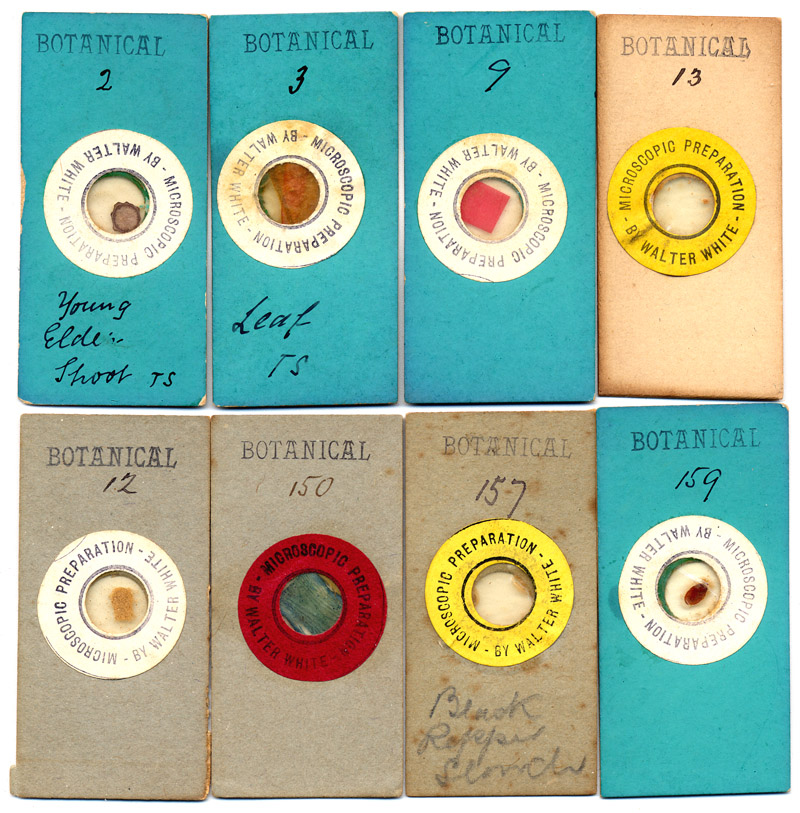
Walter White, Microscopist (1841 - ca. 1910)
Brian Stevenson, Kentucky, USA
Walter White was a chemist and druggist (pharmacist), who also had an amateur interest in botany. His botanical investigations apparently led him to microscopy side-businesses, providing specimens, a pre-mixed mounting medium and a microtome of his own design. There are no known connections between Walter White and another microscope slide-maker who sold under the name “W. White”. That mounter was the subject of a Micscape article published December, 2009.
Most advertisements and exchange offers from Walter White implied that he provided botanical materials from which the purchaser could produce their own slides. Known “slides” by Walter White are, in fact, botanical specimens held loosely between two discs of clear mica or glassine, mounted on 1 x 2 inch (2.5 x 5 cm) pieces of thin cardboard (Figure 1). Each cardboard slide was numbered, presumably by White, and corresponded with a printed list of specimens. An example of such a list was published in The Microscope during 1893 (Figure 2). Most extant preparations from White do not have specimen descriptions on the cardboard. While some slides do have written description on them, the handwriting tends to vary greatly (see Fig. 2), and so were probably written by purchasers. The August, 1894 issue of The Microscope included a 2-page article on White’s preparations (Figure 3). Note that the publisher of The Microscope, Charles Smiley, was the U.S. distributor for White’s preparations, which explains why so much magazine space was spent on White’s work (Figures 3 and 4).

Figure 1. Eight botanical preparations for making microscope slides, by Walter White. Each “slide” consists of a thin section or ground botanical object, either stained or unstained, held loosely between two discs of a flexible clear substance (described as being mica, but may actually be glassine), and attached to a 1 x 2 inch piece of thin cardboard by a gummed disc bearing the maker’s name. The numbers on each cardboard slide correspond with a specimen list that would have been provided by the seller. Some of the illustrated specimens do not correspond with White’s 1893 list, shown in Figure 2, indicating that White produced at least two different sets of specimens. The specimen descriptions seen on some slides were probably written by the purchaser.
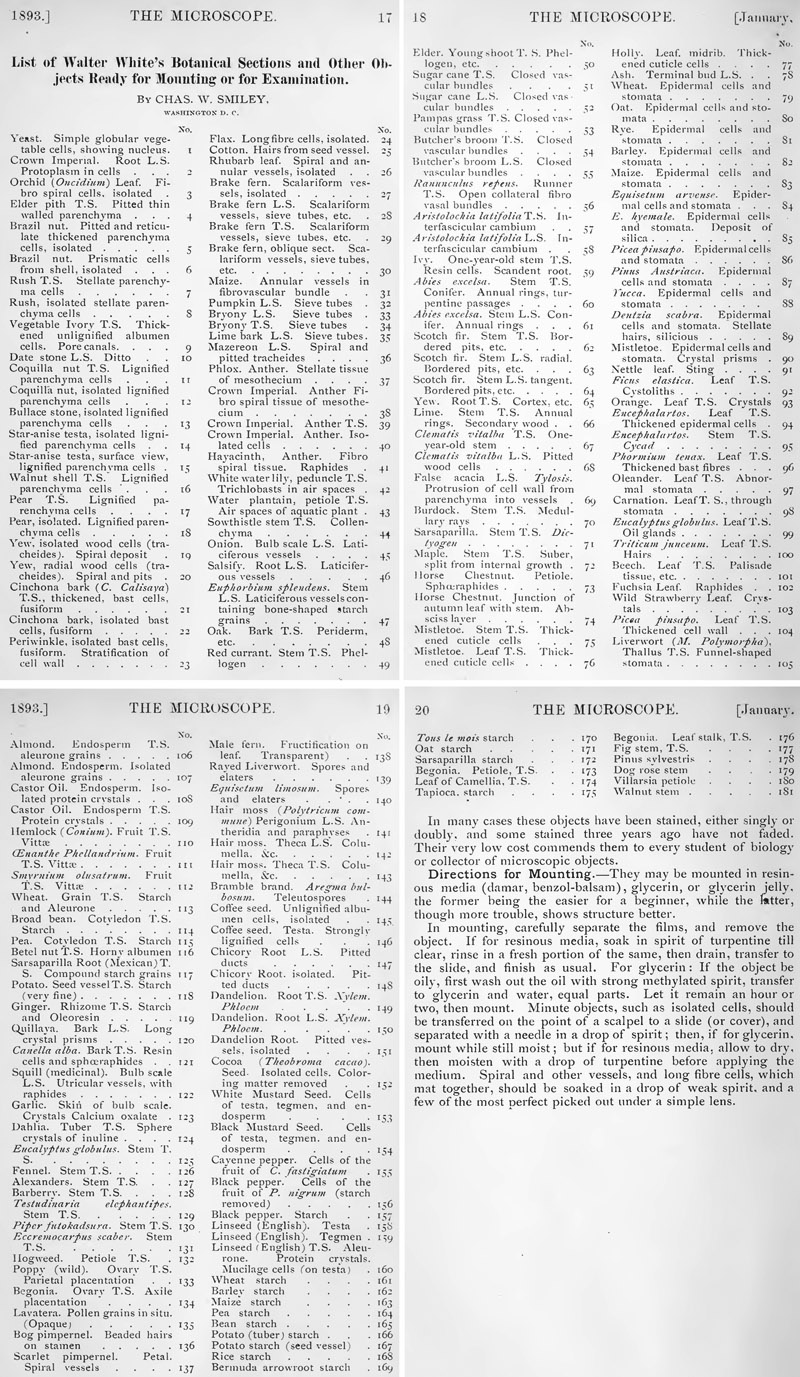
Figure 2. List of 181 specimens provided by Walter White, from The Microscope, 1893. Directions for mounting were also provided, at the end of the list.
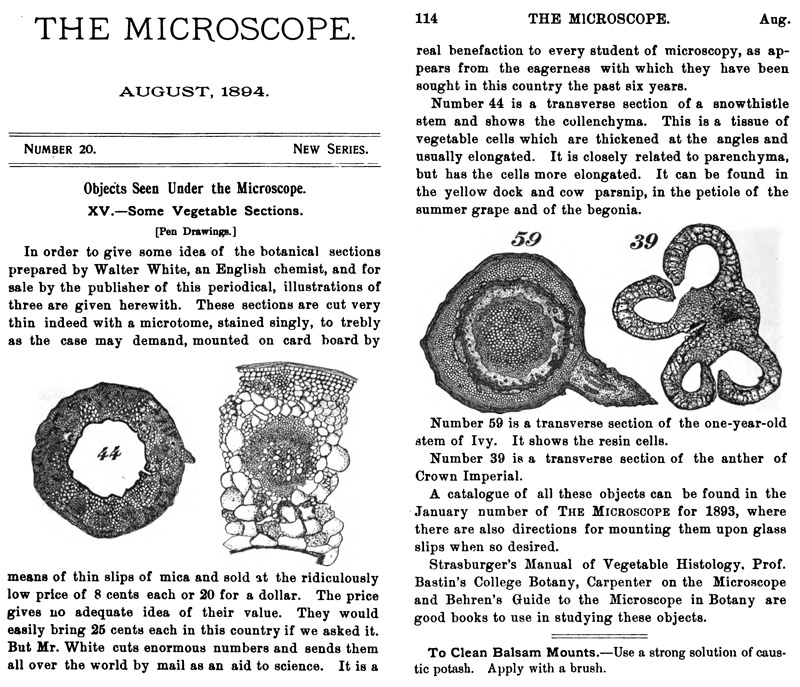
Figure 3. Further information on Walter White’s botanical preparations, from The Microscope, 1894. Note that the publisher of this magazine was also the distributor of White’s preparations in the U.S.A.
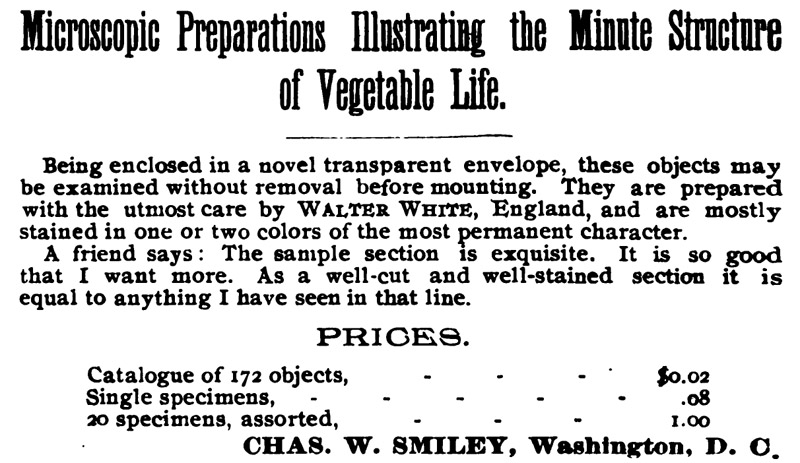
Figure 4. An advertisement for Walter White’s preparations, from the American Monthly Microscopical Journal, 1898. Charles Smiley was also the publisher of this magazine.
Walter White was born during January, 1841 in Frankley, Worcestershire. He was the first child of George and Ann White. Walter’s father was a successful farmer of 120-130 acres, an employer of 2-3 farmhands. Both the 1841 and 1851 censuses record the Whites as having employed domestic servants.
The 1861 census found 20 year-old Walter working as an assistant chemist/druggist in High Wycombe, Buckinghamshire. He and an apprentice chemist lived with their employer and a domestic servant.
Walter married Elizabeth Britcher during 1868, in Norwich, Norfolk, her hometown. Shortly thereafter, the couple moved to Monmouth, Wales, and remained there through at least April, 1871. The earliest records of White’s interests in botany and microscopy appeared in Hardwicke’s Science-Gossip during 1870. His exchange offers included: “Unmounted Objects - Mr. W. White, of Monmouth, supplies them upon very reasonable terms”, “Oblique Section of Fern - Send stamped addressed envelope to W. White, Monmouth. Any material acceptable. Wanted rare foreign wood stems”, “Longitudinal Section of Willow - Send stamped addressed envelope to W. White, Monmouth. Any microscopic material acceptable”, and “Common leaf-galls, described and figured in a previous volume. Consult exchange list, or apply to Mr. Walter White, of Monmouth”.
By 1872, White had moved to Litcham, Norfolk, and established a pharmacy shop. He was also producing Damar mounting medium, and distributing it nationwide (Figure 5). Damar, or dammar, is a resin from East Asian trees. Numerous letters to magazines such as Hardwicke’s Science-Gossip extolled the virtues of Damar over balsam. My investigations of the letters’ writers found them to be scattered throughout the U.K., with no apparent personal connections to White, suggesting that the endorsements of Damar were legitimate, and not advertisements.
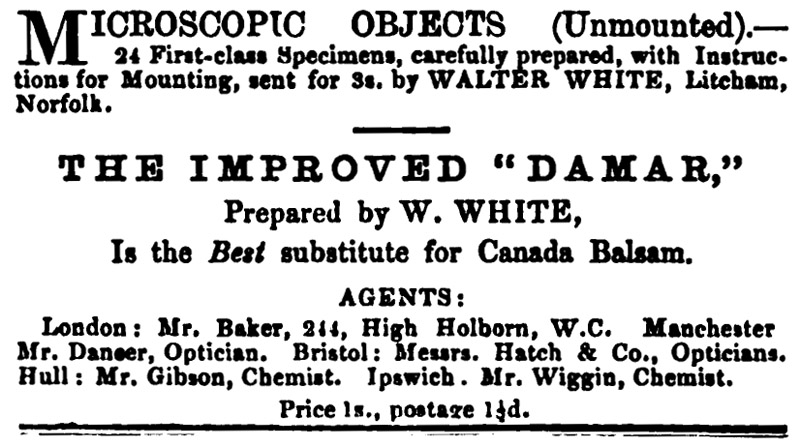
Figure 5. An 1872 advertisement for Walter White’s Damar mounting medium and specimens for making microscope slides. Note that Damar was distributed by major microscopy firms such as Baker and Dancer. From Hardwicke’s Science-Gossip.
White published a description of a new type of microtome in Hardwicke's Science-Gossip during 1872. His device used a sliding wedge to apply pressure to the object being cut. This apparently applied uniform pressure, and was deemed an improvement over screw-type microtomes. Some excerpts from the Science-Gossip article reveal information about White’s personality: “ ‘We want pretty and interesting objects.’ This is the cry, which waxes louder in proportion as our ranks are augmented by the enlistment of fresh recruits. Let me commend to their notice sections of stems, leaves, seeds, and other portions of plants. They are pretty, as well as interesting; easy to mount, and moreover, when well mounted, very permanent. How to cut them is the rub. This seems to be a great stumbling-block; consequently we find very few amateurs' cabinets containing a really good selection of vegetable sections. One will tell you he hasn't time to cut them; another, that he has tried and failed; while a third has heard so much of the difficulty of section-cutting from those who have attempted it, that he thought it useless to go to the expense of a machine. Now I hold that everybody who takes up the study of Microscopy ought to early learn how to make a good microscopic section. In Histology this acquisition is indispensable. As a means of mastering the art, nothing can be better practice than operating on the subjects before-mentioned. There is no royal road to section-cutting, any more than there is to other branches of Microscopy; yet a few practical hints may smooth the path a little, and tempt a few to turn some of their leisure moments in that direction. The first thing necessary is a section-machine; the second, a sharp-cutting instrument. Besides these, two other things are also needed – those proverbial conquerors, of all difficulties, — namely, patience and perseverance. Assuming the reader to possess the two latter, I will proceed to put him in the way to possess the former.” and “The best cutting instrument, in my humble opinion, is a razor. A small one, made of "good stuff," should be selected. If the blade is fixed in a small bradawl handle, it will be more convenient to use. As it is perfectly useless attempting to excel in section-cutting with a tool that will not stand the usual test of cutting a hair, the reader, if he be not endowed with the accomplishment of razor -sharpening, had better make friends with someone who really is, and take a practical lesson or two.”
White’s device became known as “The Science-Gossip Section-cutter”. His published description of the microtome led to demand from other microscopists, so White began selling the instrument. In 1873, Science-Gossip reported “In No. 92 (August 1, 1872), an instrument for cutting vegetable sections was figured and described by Mr. W. White, of Litcham. The instrument there described was a copy of the one he was using himself; he has since made some improvements in it, and at the request of several friends, he has had some manufactured under his own directions, and those interested in the preparation of sections of vegetable structures will do well to procure one of them. We have tried this form of section-cutter, and find it much more manageable than the old-fashioned one with the screw. The great secret of the success of the present instrument is the elevation of the material to be cut by percussion. This at once overcomes the "drag" upon the cork, which the screw often fails to do until it has been turned more than is necessary, and we get a section either too thick or unequal. The sections cut by Mr. White are certainly far superior to any we have seen before. A further advantage which most microscopists will appreciate is that the price is not above a third of that usually charged for the screw instrument. With the instrument he sends a few practical directions for its use.”
Walter White was elected as a member of the Quekett Microscopical Club on 25 July, 1873. In November of that year, he donated to the club a Science-Gossip Section-cutter and several slides of botanical sections.
Although he appears to have been primarily a botanist, White had other microscopical interests. In 1874, he advertised that he had “Diatoms from Litcham, cleaned” to exchange for any other material. In 1876, he requested “some Larvae of Tipula oleracea”. In 1877, “Wanted, a few fresh specimens of the following mollusks: Neritina fluviatilis, Valvate piscinalis, Limnea auricularia, Ancylus oblongus, Vitrina pellucida, Zonites nitidulus, Zua lubrica, Achatina acicula, Carychium minimum, Succinea. Microscopic objects, &c., or Cash offered”. During 1889, he advertised “Stained botanical preparations, mounted or unmounted, insect, and diatom mounts, offered for good water-colour drawings”. This is one of the few references by White to non-botanical microscope slides, so it is not clear whether or not he actually made the offered slides himself. However, in 1890, he offered “stained botanical preparations for any injected animal organ in mass”, implying that he was interested in mounting animal tissues.
White’s large-scale selling of microscopical specimens probably began around 1888. During that year he sent samples to Hardwicke’s Science-Gossip for the editors’ examination, an obvious advertising ploy. “Mr. Walter White, Litcham, Norfolk, has forwarded us specimens of his botanical preparations which he offers at the low price of six for a shilling. They are marvels of cheapness as well as of neatness, and have been specially got up for students of ‘Sack Thorne’ and other botanical manuals on vegetable physiology. Mr. White's list includes no fewer than 100 such illustrative slides.”
The information illustrated in Figures 2 and 3 was published in 1893 and 1894. Such advertisements continued until at least 1898. The microscopy business probably ended shortly thereafter. In 1900, White published an exchange request in Science-Gossip for “a bit of Sugar Cane, fresh or dry; also, when in season, a few fresh stems of Equisetum hytemale. Botanical or insect slides offered in exchange”. A large-scale microscopy business would probably have required much more than “a bit” of sugar cane or “a few” stems of horsetail.
Walter’s wife, Elizabeth, died in 1900. The next year’s census found Walter still working as a chemist and druggist in Litcham. His unmarried, 31 year-old daughter Gertrude lived with him. White probably died within the next decade, as he would have been well into his 60s. His son, Gilbert, who was also a chemist in Norfolk, was described in 1933 as “the son of the late Walter White, chemist, Litcham, Norfolk”. I have not been successful in locating White’s death record, and it is likely that the record has either yet to be transcribed into an accessible database or has been destroyed/lost.
Comments to the author will be welcomed.
Additional Note
The author’s previous essays on historical makers of microscopes and microscope slides are now available on-line at http://microscopist.net/ . All essays have been updated with additional pictures and information.
Acknowledgements
Many thanks to Steven Gill for his generous contributions to this and other microscopists’ biographies.
Resources
American Monthly Microscopical Journal (1898) Advertisement, Vol. 19, No. 6, page ii.
Bracegirdle, Brian (1998) Microscopical Mounts and Mounters, Quekett Microscopical Club, London.
Chemist and Druggist (1933) Obituary for Gilbert White, Vol. 118, page 61.
Dorfler, Ignaz (1902) Botaniker-Adressbuch Sammlung von Namen und Adressen der lebenden Botaniker aller Länder, Published by Im Selbsverlage des Herausgeber, page 117.
England and Wales census, birth, marriage and death records, accessed through ancestry.co.uk
English Mechanic and World of Science (1890) Vol. 49, pages 20, 208 and 446.
Hardwicke’s Science-Gossip (1870) Exchange requests, Vol. 6, pages 216, 240 and 264.
Hardwicke’s Science-Gossip (1872) Exchange requests, and advertisements, Vol. 8, pages lvii, xiii, xxx, cxxxiii, and 72.
Hardwicke’s Science-Gossip (1874) Exchange request, Vol. 10, page 42.
Hardwicke’s Science-Gossip (1876) Exchange request, Vol. 12, page 48.
Hardwicke’s Science-Gossip (1877) Exchange requests and letters, Vol. 13, pages 37, 48, 126, 160 and 183.
Hardwicke’s Science-Gossip (1883) Exchange requests and letters, Vol. 19, pages 186-187 and 264.
Hardwicke’s Science-Gossip (1887) Exchange requests and letters, Vol. 23, page 48.
Hardwicke’s Science-Gossip (1888) Microscopy, Vol. 24, pages 234-235.
Hardwicke’s Science-Gossip (1889) Exchange requests, Vol. 25, page 216.
Hardwicke’s Science-Gossip (1890) Exchange requests, Vol. 26, page 23.
Harrod & Co.’s Directory of Norfolk and Lowestoft (1877) Litcham.
Journal of the Quekett Microscopical Club (1873) Annual Meeting, Vol. 3, pages 203-206.
The Microscope (1893) New series, Vol. 1, pages 17-20.
The Microscope (1894) New series, Vol. 2, pages 113-114.
The Microscope (1895) New series, Vol. 2, pages 177-180.
Register of Chemists and Druggists (1885) page 267.
Science-Gossip (1900) Exchange requests, New series, Vol. 7, page 352.
White, Walter (1872) How to Cut Vegetable Sections, Hardwicke’s Science-Gossip, Vol. 6, pages 177-179.
White, Walter (1872) Scale-Mosses and the Microscope, English Mechanic and World of Science, no. 356, page 451.
William, Charles (1876) Damar, as a Mounting Medium, , Hardwicke’s Science-Gossip, Vol. 12, pages 254-255.
Microscopy UK Front
Page
Micscape
Magazine
Article
Library
Published in the March 2010 edition of Micscape Magazine.
Please report any Web problems or offer general comments to the Micscape Editor .
Micscape is the on-line monthly magazine of the Microscopy UK website at Microscopy-UK .
© Onview.net Ltd, Microscopy-UK, and all contributors 1995 onwards. All rights reserved. Main site is at www.microscopy-uk.org.uk .